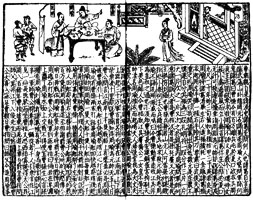History and Milieu (6)

Storytelling, storybooks and folkbooks from the Yuan to the Ming dynasty
The art of storytelling continued to play an essential role in the cultural life of the Chinese population, in town and countryside alike. The way of performance preserved essential characteristics of the genre as evidenced in the earliest sources. Some of the major constant features are: the professional status of the performer; the division of the artists according to repertoire; the shifting between prose and poetry during performance; the length of the tales leading to continued series of performances that are told and acted out in daily installments over an extended period of time. Some themes going back to the Song period are even today part of the storytellers’ repertoire, such as the semi-historical tale of ‘Three Kingdoms’. This saga was told in the bazaars of the Song capital, called ‘Telling about the Division into Three Parts’.
During the Yuan (1279-1368) and Ming (1368-1644) dynasties there was a rich development of subgenres of storytelling, and at the same time writings connected with the storytellers' tales became extremely popular. Already during Song printing of folkbooks began, called ’plain tales’ pinghua, using the genrename of certain storytelling genres. Another written genre with close ties to storytelling was the short story found in ’storybooks’ huaben. Later these books and story collections developed into independent genres of written colloquial literature, deeply influencing the creation of the great Chinese novels zhanghui xiaoshuo. The relation between the written texts and the oral tradition is a much disputed theme. Obviously, works in the written tradition are dependent on already existing oral material (plots, mythologies, etc.), but as that tradition is established, the reverse also becomes true. The written versions reciprocally gain impact on the storytellers' art.